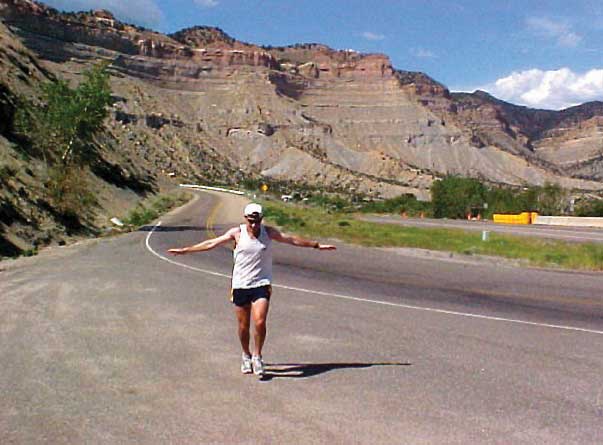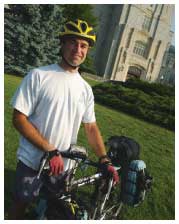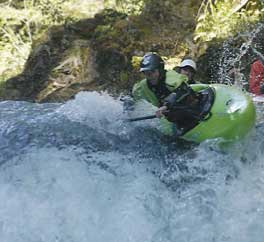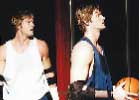
| Hokies take it to the limit by Juliet Crichton |
|
|
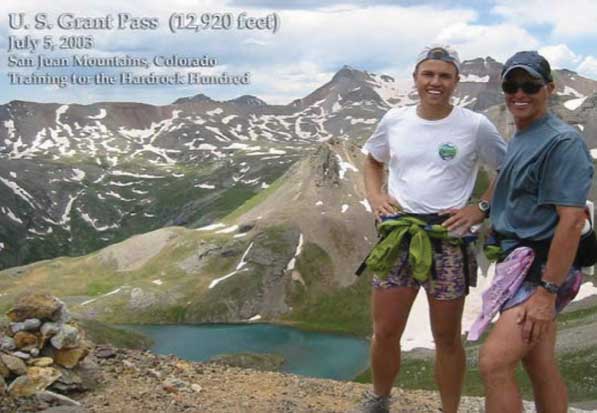 |
Faster than a speeding bullet?
More powerful than a locomotive?
Able to leap tall buildings in a single bound?
Not quite. But there are Tech alumni across the country who, as extreme athletes, run farther, cycle longer, paddle faster, fly higher, and mush harder than most of us can only imagine ... and we managed to catch up with a few of them.
|
Legs of steel?
Some may think that Eric Ostendorff (mechanical engineering '82), a Hot Wheels designer for Mattel Toys since 1983 and a lecturer in toy design at Otis College of Art and Design in Los Angeles, is a quirky guy. "Yes, I've been playing with toys for 21 years and it's still fun," he says. And even his leisure activities involve wheels.
Nicknamed "Ostrich," Ostendorff won the 2002 Furnace Creek 508, "a very hot, hilly, 508-mile non-stop bicycle race through Death Valley with some serious competition," he says. Not too shabby for the long-distance cyclist whose favorite race meal is Gummy Bears and 7-Eleven chili dogs.
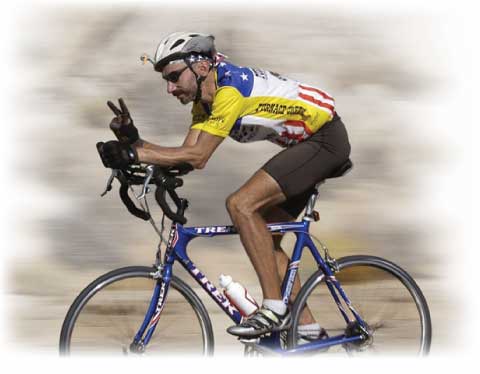 Ostendorff recalls that he and three college buddies at Tech were "good-time runners who ran every campus race, many in costume. Once, we were the Fruit of the Loom guys, and we ran inside a giant four-man pair of underwear made from bed sheets, with fruit on our heads. We formed a fake fraternity, Kappa Sigma Gamma (for Colored Socks Gang) and ran races in a giant four-man fraternity shirt I made." Ostendorff recalls that he and three college buddies at Tech were "good-time runners who ran every campus race, many in costume. Once, we were the Fruit of the Loom guys, and we ran inside a giant four-man pair of underwear made from bed sheets, with fruit on our heads. We formed a fake fraternity, Kappa Sigma Gamma (for Colored Socks Gang) and ran races in a giant four-man fraternity shirt I made."
Obviously, the toy designer trains a bit more seriously these days. "I work out five to six days a week, training a maximum of 90 run-miles per week or 700 bike-miles per week, and I compete in 10 to 20 races each year." And he's heading back to Death Valley in October for another shot at the Furnace Creek 508.
Similar training habits are undoubtedly part of the daily lives of Gary Knipling (animal science '65), a veterinarian, and his son, Keith Knipling (material sciences and engineering '98; M.S. '02), a doctoral student in material sciences and engineering at Northwestern University. The Kniplings, who have probably accumulated enough mileage between them to have traversed the globe on foot, are avid outdoorsmen who run, hike, bike, canoe, ski, and spelunk.
But the pair is most passionate about ultramarathons (50 km, 50 mile, and 100 mile races) and can claim the first--and only--father-son finish at the Boston Marathon of ultrarunning, the Hardrock 100 Endurance Race, held each year in the Rocky Mountains of Colorado. With an average altitude of 11,000 feet above sea level, a cumulative climb of 33,000 feet, an elevation change of 66,000 vertical feet (all of which must be covered within 48 hours), and a less than 50 percent finishing rate, Hardrock is, by all accounts, the most notoriously brutal 100-miler in the world. In last year's race, Keith finished in 17th place and Gary in 29th out of 69.
"Going for a run always clears my head, but running 100 miles distills my soul," says Keith, whose essay about his first 100 miler, the 1999 Massanutten Mountain Trails 100, appears in Neal Jamison's book, Running through the Wall: Personal Encounters with the Ultramarathon. Still hard at it, Keith finished 15th and Gary 27th in the Massanutten Mountain Trails 100 Mile Run in early May.
|
|
Perhaps distance runners are truly a different breed, for as Keith has written: "I have found most ultrarunners are people who ... truly realize the elemental and important aspects of life." Such sentiment seems to hold true in the case of Ben Dowdy (finance '02), who ran cross-country and track for the Hokies and was the 1997 Rookie of the Year, the 2000 Strength and Conditioning Athlete of the Year, and Timesland's 1997 Runner of the Year.
When Cave Spring High School in Roanoke, Va., was faced with funding a total renovation of its track and field complex, assistance in jumpstarting the effort came from an unexpected source: three young men wanted to run across the country to garner attention for the school and generate donations. Among them was Cave Spring alumnus Dowdy, currently a field auditor for the Audit Bureau of Circulations.
The trio, which included Laurence Loesel and Will Stewart, left San Francisco across the Golden Gate Bridge on May 12, 2003, and arrived in Roanoke on July 18 to hundreds of cheering fans. "Even with my running accomplishments, records, and awards in high school and college," Dowdy says, "the most exciting is having participated in the run across the U.S."
|
Adventure racing
The fitness manager for the University of Southern Mississippi's Division of Recreational Sports, Jackie Lebeau (human nutrition, foods, and exercise '01) is a member of a co-ed adventure racing team, Lipyank. The group is in training for two races in the fall that will each take up to 30 hours and cover approximately 100 miles--on foot, by bike, by repelling, and by canoe--with no sleep.
Adventure racing, as Lebeau explains it, "ranges from spring races (four to six hours) to endurance races (12 to 36 hours). Generally, a single race consists of several events, similar to a triathlon, that include mountain biking, trail running, orienteering, and canoeing. Teams of two to four members compete for the fastest times through the standard events, as well as through 'special tests' or 'mystery events' throughout the course."
Team Lipyank, which took third place in the Atchafalaya Adventure Race last October, trains twice a week in mountain biking and trail running and takes a weekend trip each month to cover longer distances. "I've competed in three races," says Lebeau. "Two were sprint races and were completed in less than five hours; one was an endurance race that took more than 12 hours to complete."
With that kind of adventure in one's life, who needs "Survivor"?
|
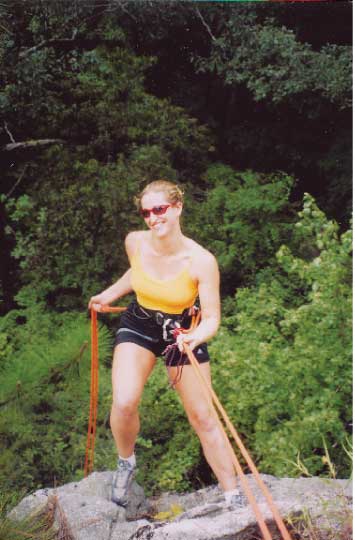
|
England to Singapore . . . by bike
|
|
Some Hokies simply have the wanderlust.
From May 2001 to April 2002, Scott Zentack (materials science and engineering '94) bicycled more than 21,000 km (translation: 13,000 miles) from England to Singapore--passing through, of all places, Siberia and the Gobi Desert--and returned to the U.S. that June to bicycle from the East to the West Coast. Seems this cyclist just can’t get enough.
Why Singapore? As one of the riders in Zentack's group put it, "Singapore is the furthest you can cycle overland without taking a ferry or flight, and it seemed a big, big challenge."
A big challenge indeed. To document the fantastic voyage, Zentack posted a website full of information for both the simply curious and the potential bicyclist. Needless to say, months of preparation for such a ride are in store. For instance, under "Health and Safety," Zentack recommends, "For my particular itinerary, I required tetanus and diphtheria shots, Hepatitis A (a series of two shots), Hepatitis B (a series of three shots), Japanese Encephalitis (a series of three shots), Typhoid, Yellow Fever, and Meningococcus.
"In addition, I received a prescription for malaria pills. ... I also took a few classes in preparation: CPR, offered through the American Heart Association; Outdoor Wilderness Survival, 16 hours of classroom and field work; and Wilderness First Aid certification, 16 hours of classroom and field work, offered through the National Safety Council."
And you thought all one had to do was pedal.
|
Whitewater, white knuckles
A professional kayaker who has taken part in 13 first descents worldwide and a three-time member of the U.S. Men's Freestyle Team, Andrew Holcomb (interdisciplinary studies '03) lives his passion daily. As the head coach for World Class Kayak Academy, a traveling high school that allows students to kayak and go to school concurrently, Holcomb spends an average of 275 days per year on the water.
Holcomb was introduced to the sport by his grandparents who co-founded North Carolina's Nantahala Outdoor Center, a company specializing in whitewater rafting and kayak instruction. "I started paddling kayaks around age seven," he says, "and I've been going ever since."
The experience has more than paid off for the young athlete. He placed second at the 2003 Freestyle World Championships in Graz, Austria; first at the 2004 American River Festival in California; and second at the 2004 Oregon Cup. Every bit the paddler, Holcomb admits, "I think the most exciting moments of the sport are every time I run a big waterfall or perform a huge air on a wave [raising the kayak out of the water by contorting the body]." No surprise there, for this kayaker regularly wins freestyle competitions that demand the most amazing tricks--such as somersaults, cartwheels, and aerial loops--in the "strong hole" located in the biggest drop of the whitewater.
With that sort of skill and love of the sport, Holcomb has indeed inspired his share of paddlers. For one, Andrew Oberhardt (computer science '02), presently a software developer and class V whitewater kayaker, says that although he started paddling at summer camp when he was a kid, "college is where it really took off, thanks to fellow Hokies Andrew Holcomb, Bryan Kirk (mining engineering '00), and Luke Hopkins (wildlife science '02), who are now professional kayakers."
A certified instructor who worked for two summers teaching kayaking to kids at the same camp where he learned, Oberhardt definitely has the whitewater bug. "I kayak as much as I can--pretty much every weekend and some evenings after work." Though he finished fifth in 2000 and third in 2001 in the expert category at the national freestyle event, the New River Rodeo, and was invited to the national championships in the fall of 2002 (which he couldn't compete in because he'd just started a new job on the West Coast), Oberhardt says his proudest moment in the sport was seeing himself in "a real production kayak video."
Always the teacher, Oberhardt helped start the Canoe and Kayak Club at Tech and taught kayaking classes in the War Memorial pool on Thursday evenings. And his college years couldn't have been in a better location: Southwest Virginia is great for whitewater, and Oberhardt reports that "West Virginia was voted 'sickest whitewater state' by one of the kayaking magazines."
In light of these Hokie kayakers' enthusiasm for whitewater thrills, we'll let you surmise what "sick" means.
Glide the friendly skies
Central Floridian Wes Lineberry (mechanical engineering '64), who retired in 2001 as a main propulsion system engineer for the Space Shuttle at Kennedy Space Center, still manages to keep things up in the air. A licensed commercial pilot with a flight instructor rating in gliders and the proud owner of an ASW-20 15 meter wingspan racing sailplane, Lineberry flies approximately 100 hours per year and participates in two or three soaring competitions annually.
One of Lineberry's latest undertakings was a seventh place finish in the transcontinental glider race "Return to Kitty Hawk," held last year from June 19 to July 4 in commemoration of the centennial of powered flight. In the race, Lineberry flew his glider from Pearblossom, Calif., to Kitty Hawk, N.C., followed on the road by his wife in the glider's trailer, which bears a big "VT" emblem. "We got at least one fellow Hokie driving a Jaguar in Texas very excited at seeing the sign," Lineberry reports.
Lineberry, one of fewer than 1,000 pilots nationwide to hold a Diamond Badge in Soaring, loves to glide almost as much as he loves Tech. "I flew in a glider contest at New Castle, Va., back in 2002," he says, "and on the first contest day, one of my turn-points was the Blacksburg Airport. My course to the airport took me directly over Lane Stadium, where I had descended to slightly less than 1,000 feet when I hit a great thermal (updraft). As I climbed to 5,000 feet, directly over the stadium, I have never sung the 'Tech Triumph' as enthusiastically as that day!"
|
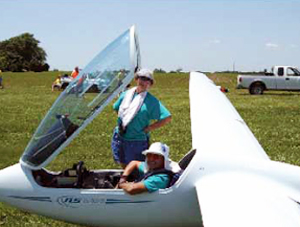
|
The first Virginian in the Iditarod!
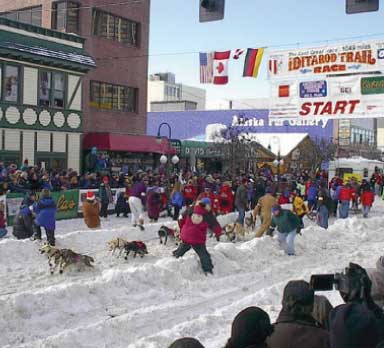 |
It's said that no other competitive event in the world can compare to the Iditarod--1,150 miles of the roughest, toughest (and most beautiful) terrain on earth, with temperatures hovering around 45-below. A dog-sled race that's run each year from Anchorage to Nome, Alaska, the Iditarod is often called the "Last Great Race on Earth," and among the mushers in this year's running was a Hokie.
Todd Denick (English education '98; M.Ed. '00), a native of Northern Virginia, moved to Fairbanks, Alaska, in mid-2001 and began training 20 sled-dogs in his spare time to pursue his goal of qualifying for the Iditarod.
A high school English teacher, Denick is now a true-blue musher who finished 12th in the Denali 300 in 2002 and eighth in the Two Rivers 200 in 2003. In this year's "great race," however, his dogs became ill and Denick chose to "scratch" at the Ophir checkpoint on March 12, having already mushed 443 miles.
Don't think for a minute that the Iditarod rookie won't be back for a sophomore effort: Iditarod XXXIII starts March 5, 2005, and Denick will no doubt be among the competitors.
|
On land, on water, in air ... admit it, you're tired. But these Hokies aren't.
The Jackson twins take on SlamBall
|
|
Anyone who follows Tech sports should remember the Hokies' "Identical Twin Towers," David Jackson (physical education '97, M.S. '99) and Jim Jackson (physical education '97, M.S. '99), who helped lead the basketball team to the 1995 NIT Championship and into the second round of the 1996 NCAA tournament.
If you saw the Jackson twins play together, you know there's an unbreakable bond between them. So it's no surprise that these two turned up on the roster of SlamBall's Diablos. (Although the league is now on hold, SlamBall is a version of basketball played on a 94-foot-by-55-foot court with four trampolines built into each end.) A tough "gunner" who led his team in scoring, David says, "I know what Jim's thinking and what he's going to do next. ... He's just like me. Only he's meaner."
|
|


